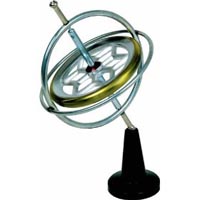 Gyroscopes defy human intuition, common sense, and even appear to defy gravity. You’ll find them in aircraft navigation instruments, games of Ultimate Frisbee, fast bicycles, street motorcycles, toy yo-yos, and the Hubble Space Telescope. And of course, the toy gyroscope (as shown here). Gyroscopes are used at the university level to demonstrate the principles of angular momentum, which is what we’re going to learn about here.
Gyroscopes defy human intuition, common sense, and even appear to defy gravity. You’ll find them in aircraft navigation instruments, games of Ultimate Frisbee, fast bicycles, street motorcycles, toy yo-yos, and the Hubble Space Telescope. And of course, the toy gyroscope (as shown here). Gyroscopes are used at the university level to demonstrate the principles of angular momentum, which is what we’re going to learn about here.
If you happen to have one of these toy gyroscopes, pull it out and play with it (although it’s not essential to this experiment). Notice that you can do all sorts of things with it when you spin it up, such as balance it on one finger (or even on a tight string). Wrap one end with string and hold the string vertically and you’ll find the gyro slowly rotates about the vertical string instead of flopping downward (as most objects do in Earth’s gravitational field). But why? Here’s the answer in plain English:
Please login or register to read the rest of this content.
Please login or register to read the rest of this content.


No, we don’t have a recommendation for any specific gyroscopes. There are lots of choices on Amazon or other online sellers.
Do you have a recommendation for a particular gyroscope?